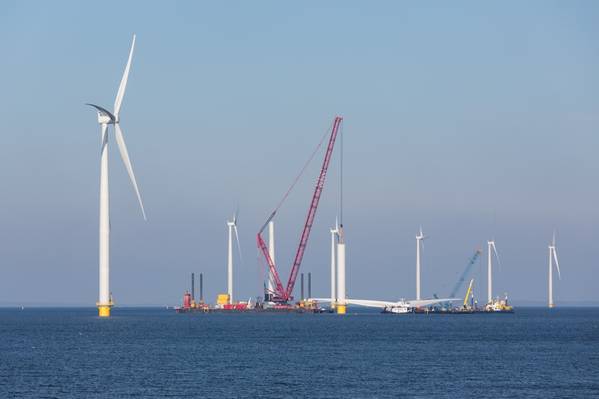
Wind power may generate roughly 40% of North America's electricity by 2050, and solar power another 32%, if current and projected capacity development plans proceed as expected, data from risk assessment firm DNV shows.
With hydropower expected to generate an additional 11.5% and nuclear a further 7.3%, over 90% of the region's electricity could come from clean sources by 2050, helping the United States and Canada realize their goal of net-zero emissions and becoming clean energy leaders by mid-century.
However, such an upbeat projection will require North America to rapidly catch up with Greater China and Europe in terms of wind power expertise.
North America must also rapidly drive down wind operating costs which are higher than in China and Europe, especially for offshore facilities that can generate far more electricity than onshore sites.
Some key renewable energy sources such as photovoltaic solar generation have already undergone drastic cost cuts in North America, and are positioned for further declines thanks to large subsidies for and investments in the production of critical components, particularly in the United States.
But for wind power generation to expand by the degree needed to attain emissions targets, more substantial cost cutting and streamlining is required throughout the entire supply chain.
In particular, the cost of floating offshore installations must fall drastically so that utilities can tap the enormous power-generating potential over deep waters. Costs are currently prohibitive while the technology is in its infancy.
WIND PLAYING CATCH UP
Since 2015, cheap components and quick installation times have driven North American utilities to increase solar power generation at more than twice the pace of wind power, data from think tank Ember shows.
Utilities determine the attractiveness of power projects by estimating the average revenue needed per unit of generated electricity to cover the lifetime costs of constructing and operating a particular facility.
Known as the levelized cost of energy (LCOE) before subsidy, the current cost for a solar photovoltaic (PV) farm is estimated at 3.4 U.S. cents per kilowatt hour (kWh), according to DNV.
That compares to around 8.6 cents for a natural gas-fired plant, and more than 18 cents for a coal-fired facility.
While solar PV is the lowest-cost option for utilities, power generation stops when the sun goes down, so utilities need to look elsewhere for around-the-clock generation.
The expected costs for a solar-plus storage facility, which generates power from batteries at night, is estimated at 10.92 cents per kWh, substantially more than a straight solar PV facility.
Since onshore wind sites cost around 4.2 cents per kWh, and fixed offshore wind farms 4.84 cents per kWh, wind power looks like the most attractive option for year-round clean power potential.
PRIMED FOR A BOOM
According to DNV's Energy Transition Outlook, North American electricity generation from all wind sources will jump from just under 500,000 gigawatt hours (GWh) in 2023 to 950,000 GWh by 2030, to 1.9 million GWh in 2040 and 3.3 million GWh by 2050.
That growth rate amounts to a 570% increase in wind generation from 2023 to 2050, and will make wind the single largest source of electricity across the region by mid-century.
But achieving such breakneck growth is easier said than done, especially in developed markets where power developers can face difficulties in expanding onshore wind sites due to local land use disputes, and in attaining permits for offshore farms due to reams of red tape.
Power developers are also struggling to complete projects on time amid lengthy delivery times for key components such as generators, turbine blades and high powered magnets.
Rising raw material costs have also pushed up component prices that must be passed on to project developers.
In China, the top producer of several key wind power parts, the price of key industrial inputs has risen notably since mid-2020, including steel (up 22%), aluminium (up 55%) and copper (up 64%), which are all critical in wind power products.
This combination of project delays and rising component prices add up to higher wind power generation costs than other sources of power, and are a key challenge for North American power developers looking to rapidly roll out more renewable energy supplies.
SECTOR SHAKE UP
To help shield developers from further cost climbs and delays, a sharp increase in the local production of wind power components will be needed within North America.
Greater local manufacturing would ensure that power producers have their own steady supplies of critical components ready for installation, reducing third-party supplier dependence and potential global supply chain snafus.
Last year's Inflation Reduction Act (IRA) looks set to spur the build out of some of that needed capacity, especially in the United States where subsidies and tax breaks will be available for firms engaged in the green energy space.
The IRA also aims to speed up permit processing for renewable projects, which would allow projects to reach completion in shorter time frames.
In combination, these measures would help reduce development costs for all types of green power, and in tandem with restrictions to the use of fossil fuels could transform North America's power mix from its current fossil-based set up into a true showcase for renewable energy potential.
<The opinions expressed here are those of the author, a columnist for Reuters.>
North America electricity generation by source 2025-2050 https://tmsnrt.rs/3LepVlt
Electricity getting greener and cheaper in North America https://tmsnrt.rs/3LgWrTS
Change in North America electricity generation costs by 2030, 2040 & 2050* https://tmsnrt.rs/41qNBJ4
(Reuters - Reporting by Gavin Maguire; Editing by Richard Chang)



